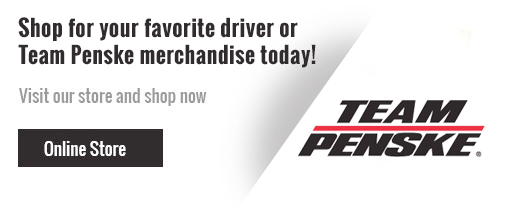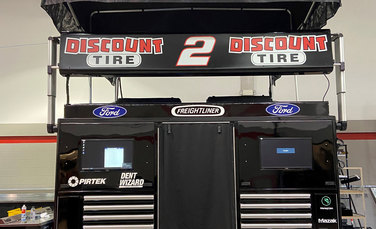Next Gen Era Brings Changes on NASCAR Pit Lane
January 19, 2022
"Penske Material" provides an inside look at some of the personalities, stories and moments that make Team Penske so unique.
Spectators pour into grandstands across the United States each weekend to watch world-class race cars and teams test the limits of physics in a quest to be the fastest. Likewise, pit crews train tirelessly to be the quickest to service their respective cars to maintain or gain track position during a race. While the battles on the track often steal the headlines on Monday morning, behind the scenes, the effort to get the most out of the performance on pit lane often makes the difference between winning and losing.
Winning the pit lane battle goes deeper than just athlete preparation. It’s certainly evident on the modern-day NASCAR pit crews, where there’s been an increased focus on making sure the sport’s athletes have the best equipment possible at all times. Pit equipment has evolved steadily through the history of racing.
Among the Team Penske NASCAR teams, pit lane preparation ramps up in the off-season, shortly after the final checkered flag of the season falls at Phoenix Raceway. The impressive “War Wagons” – as NASCAR pit boxes have been nicknamed – return to the race shop, often for the first time in over 20 weeks. Typically, the massive boxes used for housing pit equipment, seating crew chiefs, engineers and VIP guests spend the season on the road, traveling from race to race with Champion Tire and Wheel as the boxes simply grew too large to be loaded into the race team haulers.
Once the boxes arrive at the race shop, the road crew mechanics spend time deconstructing the multi-purpose mobile work areas, removing and inventorying all equipment and preparing for any technical upgrades that the new season will bring. Any given NASCAR box can contain upwards of 800 tools, parts, pieces and other individual items. The pit crew and road crews work together to make sure the boxes stay stocked at the track, carefully chronicling what’s needed as the boxes make very limited trips back to Team Penske headquarters throughout the season. In between seasons, the pit boxes are stripped down, painted and all new sponsor logos and branding is added for the upcoming season. Additionally, all of the hardware on the seating areas and viewing deck are replaced before the boxes are prepped for first green flag of the new year.
With NASCAR ushering in the Next Gen car for the 2022 Cup Series season, teams have adjusted to changing demands. A new, heavier air impact wrench will be a staple on pit lane this year with teams transitioning to the single wheel-nut system used in INDYCAR, Formula 1 and global sports car racing platforms. With the change, teams are expected to see pit stop times drop significantly, which means less margin for error than ever before.
NASCAR will continue to issue teams industry-standard Paoli impact wheel guns on race day, but the pit crews need to get their practice in during the week, the time when Travis McFarland has become an even more important member of Team Penske.
McFarland is responsible for maintaining Team Penske’s NASCAR pit equipment. Everything from practice jacks, to race jacks, practice guns, helmets and other essential equipment is under his watch. The five-year member of Team Penske and 18-year motorsports veteran has a pretty consistent schedule during race season with Monday’s dedicated to servicing and inspecting all the team’s race jacks. Tuesday is spent doing thorough safety inspections on helmets, helmet lights and cameras and preparing them to be loaded back onto the hauler for the upcoming event. Wednesday is dedicated to servicing pit practice equipment, including the in-house Paoli air guns and the team’s pit practice car. With the change to the new single wheel-nut system, the guns are constructed virtually the same, but with bigger components to utilize the new larger titanium socket.
According to long-time Team Penske rear tire changer Zach Price, the new air guns and single wheel-nut stops provide a difference of night and day from 2021 to 2022.
“Everything feels and sounds different and it’s honestly a different process completely,” said Price. “The feel of the gun and where I feel the vibration in my hand is different, the need for gun angle accuracy is also at a new premium. If you don’t hit this nut at the perfect angle or if you try to hit it before you’re fully engaged, it’ll fly off and be down pit road. With the five lugnut stops we’d try to have the gun spinning at the highest RPM possible before contact, with this system the gun has to be completely stopped.”
In addition to the fastening moving from five lugnuts to a central wheel nut, Price pointed out one major advantage in the new 18-inch wheel design.
“When you’re pulling the wheel with the new design we can get an entire handful of wheel, previously we could only get about two fingers inside the opening on the 15” steel wheels,” added Price. “That said, the new wheels are pretty front heavy so if you’re not careful you’ll put your tire carrier in a hole because the wheel will fall over.”
While NASCAR issues air guns to the teams, the jacks will continue to be different from team to team. Each jack is thoroughly inspected and serviced after every race, ensuring optimal functionality. Team Penske works to stay ahead of the competition by evolving its components with the help of some of the team’s technical partnerships. The while the Next Gen car will weigh the same on paper as the Gen 6 car, it will present a new challenge in jacking with an independent rear suspension. Teams will have to continue to engineer ways to make the jacks lift faster with less force from the jackman.
While some of the equipment has changed, the focus remains the same. From preparation at the shop to execution at the track, the outcomes of many of the biggest races in NASCAR will continue to be impacted by the performance of the teams and their crews on pit road.
More Penske Material
Read more about the personalities, stories and moments that make Team Penske unique.







